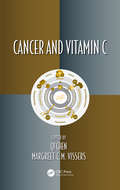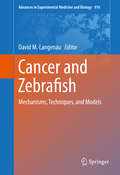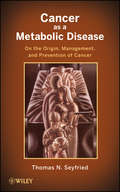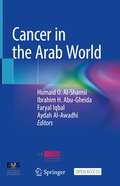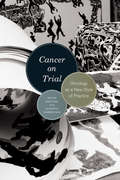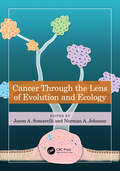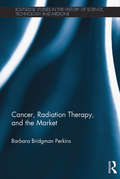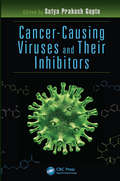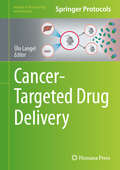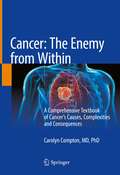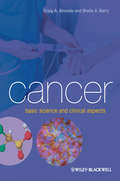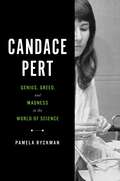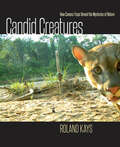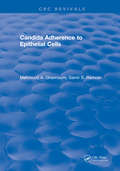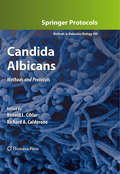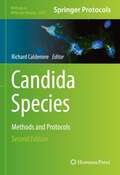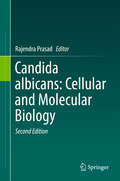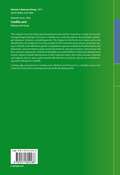- Table View
- List View
Cancer and Vitamin C (Oxidative Stress and Disease #48)
by Qi Chen Margreet C.M. VissersVitamin C may offer significant therapeutic benefits in the treatment of cancer. This book includes chapters by a group of leading scientific researchers documenting the ways cancer can be affected by high doses of ascorbate. After an initial chapter providing a historical perspective, subsequent chapters focus on cancer cell death, reprogramming of somatic cells, recent case studies, and other ways vitamin C can improve outcomes of therapy. Features Includes chapters from a team of leading international scholars Reviews the history of beneficial uses of vitamin C in the treatment of cancer Summarizes recent case studies Discusses how vitamin C may synergistically affect other cancer treatment methods
Cancer and Zebrafish: Mechanisms, Techniques, and Models (Advances in Experimental Medicine and Biology #916)
by David M. LangenauThis volume focuses on defining the unique attributes of using the zebrafish cancer model for discovering important pathways and potential drug targets for the treatment of human cancers. Using the zebrafish model, the volume explores oncogene and tumor suppressor discovery, chemical genetic approaches, genomics, epigenetics, cancer imaging, and cell transplantation. Contributed chapters come from the most prominent laboratories working in this field, which provides a unique perspective on zebrafish models from a wide spectrum of the research community. In addition, the book offers a detailed analysis of the most current research in the area for specific zebrafish cancer models, including T cell leukemia, rhabdomyosarcoma, liver and pancreatic cancer, melanoma, neuroblastoma, germ cell tumors, and malignant peripheral sheath tumors. A chapter is also dedicated to the development and utilization of other piscine models of cancer. The compilation of chapters in the volume culminates into a comprehensive and definitive text on zebrafish and cancer, providing a much needed resource on the powerful attributes of the zebrafish model system.
Cancer and the Search for Selective Biochemical Inhibitors
by E.J. HoffmanThe world of medicine has become splintered into two factions, that of orthodoxy and its counterpart, alternative or complementary medicine. A problem with alternative medicine is, of course, that of anecdote and hearsay. The solution: the disclosure, in an unassailable fashion, of the underlying biochemical principles for alternative cancer therap
Cancer as a Metabolic Disease
by Thomas SeyfriedThe book addresses controversies related to the origins of cancer and provides solutions to cancer management and prevention. It expands upon Otto Warburg's well-known theory that all cancer is a disease of energy metabolism. However, Warburg did not link his theory to the "hallmarks of cancer" and thus his theory was discredited. This book aims to provide evidence, through case studies, that cancer is primarily a metabolic disease requring metabolic solutions for its management and prevention. Support for this position is derived from critical assessment of current cancer theories. Brain cancer case studies are presented as a proof of principle for metabolic solutions to disease management, but similarities are drawn to other types of cancer, including breast and colon, due to the same cellular mutations that they demonstrate.
Cancer in the Arab World
by Humaid O. Al-Shamsi Ibrahim H. Abu-Gheida Faryal Iqbal Aydah Al-AwadhiThis is an Open Access book. This book is a must-have for healthcare providers and researchers, public health specialists and policy makers who are interested and involved in cancer care in the Arab world. The Arab world consists of 22 countries, which are members of the Arab League and spanning over 13,132,327 km2 with over 423,000,000 population. Over the past few decades, the Arab world has witnessed a swift evolution in healthcare provision. Nonetheless, Arab countries have considerable variability in economic capabilities, resource allocation, and intellectual talent that inevitably reflect on access to modern cancer care and prevention. This book is authored by experts from the Arab world who provide vital information on cancer statistics and risk factors, available clinical care pathways and infrastructure, and prevention programs in their individual countries. The chapters also address specific challenges in each country and insights into future directions to achieve optimal care with conventional and novel diagnostics and therapies to keep up with the era of precision medicine. Special topics of interest and unique to the Arab world are also discussed, such as out of the country’s medical tourism for cancer care and cancer care during war and conflict. Other special chapters include: Cancer research in the Arab world, Radiation therapy in Arab World and Pediatric Oncology in the Arab World Cancer in the Arab World is the first comprehensive book that addresses cancer care in depth in all Arab countries and it is endorsed by the prestigious Emirates Oncology Society.
Cancer of the Testis
by Jerome P. Richie Peter Albers Carsten Bokemeyer M. Pilar LagunaThe book covers the complete field of testis cancer including the germ cell tumors and the stromal tumors, from epidemiology to new chemotherapeutic agents and schedules, throughout genetic features, risk factors, risk adapted treatments, role of different types of surgery and special clinical situations. Special attention is focused on fertility issues, late effects of the primary therapy and the economical aspects of the different treatment policies. As a result of the third Consensus Conference, a consensual follow-up can be devised and a chapter dedicated to this controversial and not yet defined matter. This book is the state-of-the-art reference text on testis cancer and is an essential resource for all urologists, medical oncologists and radio-oncologists.
Cancer on Trial: Oncology as a New Style of Practice
by Peter Keating Alberto CambrosioUntil the early 1960s, cancer treatment consisted primarily of surgery and radiation therapy. Most practitioners then viewed the treatment of terminally ill cancer patients with heroic courses of chemotherapy as highly questionable. The randomized clinical trials that today sustain modern oncology were relatively rare and prompted stiff opposition from physicians, who were loath to assign patients randomly to competing treatments. Yet today these trials form the basis of medical oncology. How did such a spectacular change occur? How did medical oncology pivot from a nonentity and, in some regards, a reviled practice to the central position it now occupies in modern medicine? In Cancer on Trial Peter Keating and Alberto Cambrosio explore how practitioners established a new style of practice, at the center of which lies the cancer clinical trial. Far from mere testing devices, these trials have become full-fledged experiments that have redefined the practices of clinicians, statisticians, and biologists. Keating and Cambrosio investigate these trials and how they have changed since the 1960s, all the while demonstrating their significant impact on the progression of oncology. A novel look at the institution of clinical cancer research and therapy, this book will be warmly welcomed by historians, sociologists, and anthropologists of science and medicine, as well as clinicians and researchers in the cancer field.
Cancer through the Lens of Evolution and Ecology
by Norman A. Johnson Jason A. SomarelliCancer cells exist in an ever-changing “ecology” and are subject to evolutionary pressures just like any species in nature. This edited book explores the following themes: 1) how the dynamics of mutation, epigenetics, and gene expression noise are sources of genetic diversity; 2) how scarce resources influence cancer therapy resistance; 3) how predator-prey dynamics are mirrored in immune-cancer cross-talk; 4) how cancer cells parallel niche construction theory; 5) how changing fitness landscapes enable cancer growth; and 6) how cancer cells interact within the body. The book is a resource for understanding cancer as a disease of multicellularity grounded in evolutionary principles. By using this knowledge, researchers are starting to exploit these behaviors for treatment paradigms.Key Features Bridges disciplines exemplifying the ways disparate fields create new perspectives when integrated. Offers insights from leading scholars in cancer biology, ecology and evolutionary biology. Provides a timely recognition by oncologists that evolutionary paradigms are crucial for breakthroughs in cancer treatment. Integrates basic and applied sciences of oncology and evolutionary biology.
Cancer, Radiation Therapy, and the Market: Cancer Guns (Routledge Studies in the History of Science, Technology and Medicine)
by Barbara Bridgman PerkinsAppraising cancer as a major medical market in the 2010s, Wall Street investors placed their bets on single-technology treatment facilities costing $100-$300 million each. Critics inside medicine called the widely-publicized proton-center boom "crazy medicine and unsustainable public policy." There was no valid evidence, they claimed, that proton beams were more effective than less costly alternatives. But developers expected insurance to cover their centers’ staggeringly high costs and debts. Was speculation like this new to health care? Cancer, Radiation Therapy, and the Market shows how the radiation therapy specialty in the United States (later called radiation oncology) coevolved with its device industry throughout the twentieth-century. Academic engineers and physicians acquired financing to develop increasingly powerful radiation devices, initiated companies to manufacture the devices competitively, and designed hospital and freestanding procedure units to utilize them. In the process, they incorporated market strategies into medical organization and practice. Although palliative benefits and striking tumor reductions fueled hopes of curing cancer, scientific research all too often found serious patient harm and disappointing beneficial impact on cancer survival. This thoroughly documented and provocative inquiry concludes that public health policy needs to re-evaluate market-driven high-tech medicine and build evidence-based health care systems.
Cancer-Causing Viruses and Their Inhibitors
by Satya GuptaCancer-causing viruses, also called oncoviruses, play a key role in the development of certain cancers. They contribute to genetic changes that disrupt the cell cycle machinery, interfering with functions such as cell growth. Cancer-Causing Viruses and Their Inhibitors presents a plethora of research from internationally reputed contributors who discuss different types of oncoviruses, their mechanisms of invasion and growth, and their life cycles. <P><P>The book begins with an overview of the oncoviruses discovered to date and includes a brief description of their structures, genotypes, replication, and mechanisms of infection leading to cancers. It then explores several of these viruses in detail, including: <li>Human T-cell leukemia virus type 1 (HTLV-1) <li>Hepatitis C virus (HCV) <li>Epstein–Barr virus (EBV) <li>Human papilloma virus (HPV) <li>Human herpes virus 8 (HHV-8)/Kaposi’s sarcoma-associated herpes virus (KSHV) <li>Human immunodeficiency virus (HIV/AIDS) <li>Oncolytic viruses <P><P>This book is an essential reference for those working in virology, oncology, and biotechnology. The discoveries presented will enable researchers and clinicians to optimize both historical and current approaches to anti-viral therapies.
Cancer-Targeted Drug Delivery (Methods in Pharmacology and Toxicology)
by Ülo LangelThis detailed volume explores the frontiers of tumor targeting approaches in the field of tumor-targeted drug delivery and cancer therapy. Several topics involve the improvement of cancer detection and treatment using nanotechnologies, where the main challenge to transition from the laboratory to the clinic, with more effective, targeted, and less invasive treatments. Written for the Methods in Pharmacology and Toxicology series, chapters provide the kind of detailed implementation advice needed for successful future studies. Authoritative and innovative, Cancer-Targeted Drug Delivery serves as the ideal reference for researchers using current cutting-edge technologies for tumor-targeting of drugs.
Cancer: A Comprehensive Textbook of Cancer’s Causes, Complexities and Consequences
by Carolyn ComptonThis comprehensive, ground-breaking title presents, in simplifying style, the driving and organizing principles of cancer, making this multidimensional, highly complex disease easily understandable for readers. Developed out of the renowned author’s many years of teaching a widely popular, several-hundred-student college course, this 12-chapter book begins with an account of the history of cancer as a medical and public health problem, as well as the major milestones and setbacks in the ongoing quest to understand the wide variety of cancers that continue to impact the world. Subsequent chapters then address pathogenesis, incidence and mortality statistics, risk factors, causal factors, screening challenges and victories, treatment strategies, and disease prevention approaches. This wealth of clinical information is further supplemented with socioeconomic discussions on the financial, social, ethical, technological, regulatory, political, and logistical challenges that limit progress in cancer research. A soon to be gold-standard text that thoroughly and expertly describes cancer as a composite, adaptive system, Cancer: The Enemy from Within equips and empowers all undergraduate students and graduate students to better understand this continually perplexing disease. Clinicians across all disciplines may also find this work of great interest.
Cancer: Basic Science and Clinical Aspects
by Sheila A. Barry Craig A. Almeida“... Useful background information is displayed in blue boxes, and good use is made of numerous tables and diagrams... a useful book for the undergraduate medical or allied health professional...” –Oncology News, May/June 2010 This forward looking cancer biology book appeals to a wide ranging audience. Introductory chapters that provide the molecular, cellular, and genetic information needed to comprehend the material of the subsequent chapters bring unprepared students up to speed for the rest of the book and serve as a useful refresher for those with previous biology background. The second set of chapters focuses on the main cancers in terms of risk factors, diagnostic and treatment methods and relevant current research. The final section encompasses the immune system’s role in the prevention and development of cancer and the impact that the Human Genome Project will have on future approaches to cancer care. While best suited to non-majors cancer biology courses, the depth provided satisfies courses that combine both majors and non-majors. Also, and deliberately, the authors have incorporated relevant information on diagnosis and treatment options that lend appeal to the lay reader.
Cancer: Prevention, Early Detection, Treatment and Recovery
by Gary S. Stein Kimberly P. LuebbersA guide to recent insights into the genetic and epigenetic parameters of cancer biology and pathology and emerging clinical applications The thoroughly updated second edition of The Biology and Treatment of Cancer, now titled Cancer: Prevention, Early Detection, Treatment and Recovery, goes beyond reviewing the fundamental properties of cancer biology and the relevant issues associated with treatment of the disease. The new edition contains coverage of additional "patient centric" topics and presents cancer biology with selection of topics, facts, and perspectives written in easy-to-understand terms. With contributions from noted experts, the book explores recent advances in the understanding of cancer including breakthroughs in the molecular and cellular basis of cancer and provides strategies for approaching cancer prevention, early detection, and treatment. The authors incorporate recent information on the genetic and epigenetic parameters of cancer biology and pathology with indications of emerging clinical applications. The text offers a unique guide to cancer prevention, early detection, treatment, and recovery for students, caregivers, and most importantly cancer patients. This significant book: Incorporates current insight into the genetic and epigenetic parameters of cancer biology and pathology and information on emerging clinical applications Contains contributions from leaders in cancer research, care, and clinical trials Offers an accessible guide to an accurate and balanced understanding of cancer and the cancer patient Focuses on the importance of cancer prevention, early detection, treatment, and survivorship Written for medical students, students of cancer biology, and caregivers and cancer patients, Cancer: Prevention, Early Detection, Treatment and Recovery offers an authoritative overview of the challenges and opportunities associated with cancer biology, cancer research, and the spectrum of clinical considerations.
Candace Pert: Genius, Greed, and Madness in the World of Science
by Pamela RyckmanCandace Pert stood at the dawn of three revolutions: the opioid crisis, the AIDS crisis, and the mind-body movement. Indeed, her visionary work shaped history – for good and, inadvertently, for evil. Before there was Bessel van der Kolk, there was Candace Pert, the Mother of the Mind-Body Revolution. Her story forms a launchpad to discuss the most pressing issues plaguing science and healthcare today. Pert played pivotal roles in major movements in both science and politics. Namely, she: Discovered the opiate receptor (the mechanism by which opioids function in the brain), launching the opioid crisis. Proved the mind-body link, launching the field of integrative or functional medicine. Created Peptide T, the underground AIDS drug featured in the film Dallas Buyers Club, and then went rogue, becoming a linchpin in the black market for her drug. Pert was sabotaged by mentors and colleagues keen to profit from her brilliance. But she too became tainted, believing that her noble ends would justify devious means. Like a mythic hero, she succumbed to a fatal flaw, and her greatest strengths—singularity of purpose and blind faith in her own virtuosity—would prove to be her undoing. CANDACE PERT is a great read for anyone interested in integrative health, mind-body awareness, medical ethics, the bureaucracy of a toxic healthcare system, and a flawed genius whose scandals and breakthroughs shaped history. &“Exemplary research, balanced accounts and deeply evocative prose... a truly insightful narrative on what it can mean to be a woman at the cutting edge of science.&” – The Wall Street Journal &“Riveting biography… nuanced portrait…Readers will be engrossed.&” – Publisher's Weekly &“There is a revolution taking form that is significantly influencing how the Western medical community views health and disease. Candace Pert&’s contribution to this revolution is undeniable.&” – Deepak Chopra &“Ryckman&’s writing is life-like, suspenseful, and creates a roller coaster ride of stakes and unexpected discovery&” – Dr. Lisa Miller, New York Times bestselling author of The Spiritual Child and The Awakened Brain
Candid Creatures: How Camera Traps Reveal the Mysteries of Nature
by Roland KaysA riveting collection of photographs that captures wild animals in their native habitats.In Candid Creatures, the first major book to reveal the secret lives of animals through motion-sensitive game cameras, biologist Roland Kays has assembled over 600 remarkable photographs. Drawing from archives of millions of color and night-vision photographs collected by hundreds of researchers, Kays has selected images that show the unique perspectives of wildlife from throughout the world. Using these photos, he tells the stories of scientific discoveries that camera traps have enabled, such as living proof of species thought to have been extinct and details of predator-prey interactions.Each image captures a moment frozen in the camera’s flash as animals move through their wild habitats. Kays also discusses how scientists use camera traps to address conservation issues, creating solutions that allow humans and wild animals to coexist. More than just a collection of amazing animal pictures, the book’s text, maps, and illustrations work together to describe the latest findings in the fast-moving field of wildlife research. Candid Creatures is a testament to how the explosion of game cameras around the world has revolutionized the study of animal ecology. The powerful combination of pictures and stories of discovery will fascinate anyone interested in science, nature, wildlife biology, or photography.
Candida Adherence to Epithelial Cells
by Mahmoud A. GhannoumThis is the first book ever to be published on this topic! Comprehensively packed with up-to-date research information, this volume is written with both the beginner and the established research expert in mind. Complemented with tables, line drawings, and photographs, this resource provides background material which allows the reader to become familiar with Candida albicans and its relation to its host. This unique work places particular emphasis on the effect of therapeutic agents on adherence and adherence blockage in the control of Candidosis. The goal of these studies is to be of practical value in the control and prevention of Candida infections. This book is of specific interest to all who are involved (at any level) with microbiology, infectious diseases, medical and veterinary mycology, and chemotherapy.
Candida Albicans: Methods and Protocols (Methods in Molecular Biology #499)
by Richard A. Calderone Ronald L. CihlarOver the course of the past decade, there have been remarkable advances in the study of human pathogenic fungi. These developments have taken place throughout a wide range of disciplines, and have come as the result of newly available genome sequences of pathogens such as candida albicans and other model fungi. In Candida Albicans: Methods and Protocols, expert researchers explore these exciting new insights, focusing on the study of medically important fungi and Candida spp in particular. Chapters examine critical aspects of molecular methods, providing information on reporter gene assays, transformation, gene expression in vivo, and methods for large-scale gene disruption. At the same time, the work includes in-depth descriptions of disease models of candidiasis, facts about strain identification, and guidelines on the preparation of samples for proteomic investigations and tandem affinity purification. Composed in the highly successful "Methods in Molecular BiologyTM" series format, each chapter contains a brief introduction, step-by-step methods, a list of necessary materials, and a Notes section which shares tips on troubleshooting and avoiding known pitfalls. Authoritative and cutting edge, Candida Albicans: Methods and Protocols is an invaluable source of methods for investigators in the exhilarating fields of medical and molecular mycology.
Candida Species: Methods and Protocols (Methods in Molecular Biology #2542)
by Richard CalderoneThis updated volume explores Candida and candidiasis methods, useful to a wide variety of Candida scientists including those new to the field. Beginning with a section on the Candida genome, the book continues by covering techniques for antifungal discovery and studying resistance, pathogenesis and virulence, communities, as well as immunity. Biofilm protocols are also featured. Written for the highly successful Methods in Molecular Biology series, chapters include introductions to their respective topics, lists of the necessary materials and reagents, step-by-step, readily reproducible laboratory protocols, and tips on troubleshooting and avoiding known pitfalls. Authoritative and up-to-date, Candida Species: Methods and Protocols, Second Edition serves as an ideal guide for researchers working to further our understanding of this family of infective fungi.
Candida albicans: Cellular And Molecular Biology
by Rajendra PrasadThis book on Candida albicans and similar pathogens provides a timely overview of the groundbreaking discoveries made in the areas of drug resistance, host–pathogen interactions, virulence, host immune system modulation, etc., in the last two decades. This comprehensive 2nd Edition includes chapters on fungal infections, hyphal morphogenesis, molecular mechanisms of antifungal resistance, antifungal agents, multidrug transporters, virulence mechanisms in Candida albicans, host–pathogen interactions, the cell wall, fungal biofilms, lipids and antifungal resistance, signaling mechanisms and last but not the least host-immune responses. As such, it offers an ideal reference guide for mycologists, researchers, pharmacists, clinicians, and undergraduate students engaged or interested in fungal research. It will also benefit clinicians, who are required to keep abreast of the current state of research on antifungal drug resistance and antifungal development.
Candida auris: Methods and Protocols (Methods in Molecular Biology #2517)
by Alexander LorenzThis volume covers the latest experimental protocols used by researchers to study the recently emerged fungal pathogen of humans, Candida auris, and also explores the pathogen’s antifungal resistance, virulence, and pathogenicity. The chapters in this book cover topics such as the identification of C. auris in clinic samples by PCR and mass spectrometry; molecular typing to identify clade affiliation; genetic manipulation; genome analysis by bioinformatics; and phenotypic characterization using various biochemical, mass spectrometry, microscopy, and flow cytometry approaches. Written in the highly successful Methods in Molecular Biology series format, chapters include introductions to their respective topics, lists of the necessary materials and reagents, step-by-step, readily reproducible laboratory protocols, and tips on troubleshooting and avoiding known pitfalls.Cutting-edge and practical, Candida auris: Methods and Protocols is a valuable resource for researchers interested in learning more about this developing field.
Candy Experiments (Candy Experiments Ser. #1)
by Loralee LeavittCandy is more than a sugary snack. With candy, you can become a scientific detective. You can test candy for secret ingredients, peel the skin off candy corn, or float an &“m&” from M&M&’s. You can spread candy dyes into rainbows, or pour rainbow layers of colored water. You'll learn how to turn candy into crystals, sink marshmallows, float taffy, or send soda spouting skyward. You can even make your own lightning.Candy Experiments teaches kids a new use for their candy. As children try eye-popping experiments, such as growing enormous gummy worms and turning cotton candy into slime, they&’ll also be learning science. Best of all, they&’ll willingly pour their candy down the drain.Candy Experiments contains 70 science experiments, 29 of which have never been previously published. Chapter themes include secret ingredients, blow it up, sink and float, squash it, and other fun experiments about color, density, and heat. The book is written for children between the ages of 7 and 10, though older and younger ages will enjoy it as well. Each experiment includes basic explanations of the relevant science, such as how cotton candy sucks up water because of capillary action, how Pixy Stix cool water because of an endothermic reaction, and how gummy worms grow enormous because of the water-entangling properties.
Cane-based Biofuels And Bioproducts
by Sagadevan MundreeSugarcane has garnered much interest for its potential as a viable renewable energy crop. While the use of sugar juice for ethanol production has been in practice for years, a new focus on using the fibrous co-product known as bagasse for producing renewable fuels and bio-based chemicals is growing in interest. The success of these efforts, and the development of new varieties of energy canes, could greatly increase the use of sugarcane and sugarcane biomass for fuels while enhancing industry sustainability and competitiveness. Sugarcane-Based Biofuels and Bioproducts examines the development of a suite of established and developing biofuels and other renewable products derived from sugarcane and sugarcane-based co-products, such as bagasse. Chapters provide broad-ranging coverage of sugarcane biology, biotechnological advances, and breakthroughs in production and processing techniques. This text brings together essential information regarding the development and utilization of new fuels and bioproducts derived from sugarcane. Authored by experts in the field, Sugarcane-Based Biofuels and Bioproducts is an invaluable resource for researchers studying biofuels, sugarcane, and plant biotechnology as well as sugar and biofuels industry personnel.
Canine Confidential: Why Dogs Do What They Do
by Marc BekoffGet to know your best friend better: “Everyone who owns a dog, breeds or trains dogs, or works with dogs should read this informative book.” —Library JournalJust think about the different behaviors you see at a dog park. We have a good understanding of what it means when dogs wag their tails—but what about when they sniff and roll on a stinky spot? Why do they play tug-of-war with one dog, while showing their bellies to another? Why are some dogs shy, while others are bold? What goes on in dogs’ heads and hearts—and how much can we know and understand?Written by award-winning scientist—and lifelong dog lover—Marc Bekoff, Canine Confidential not only brilliantly opens up the world of dog behavior, but also helps us understand how we can make our dogs’ lives better. Rooted in the most up-to-date science on cognition and emotion—fields that have exploded in recent years—Canine Confidential is a wonderfully accessible treasure trove of new information and myth-busting. Peeing, we learn, isn’t always marking; grass-eating isn’t always an attempt to trigger vomiting; it’s okay to hug a dog—on their terms; and so much more. There’s still much we don’t know, but at the core of the book is the certainty that dogs do have deep emotional lives, and that as their companions and trainers we must recognize them as the unique, complex individuals they are—so we can keep them as happy and healthy as possible.“Bekoff shares his own studies and others’ research, along with real-life stories, in a winning tone.” —Booklist
Canine Connection: How Dogs and Humans Evolved Together (Orca Wild)
by Christopher GudgeonDogs understand humans better than any other animal does, even chimpanzees, our closest relatives. Dogs are experts in human body language and expressions, and over time the muscles around their eyes have even adapted so they can communicate more easily with humans. And why do you get that warm feeling when you gaze into your dog’s eyes? It's because of increased levels of oxytocin, the “love” hormone. It creates feelings of affection, trust and social bonding. None of this is a coincidence. The bond humans have with dogs is the result of tens of thousands of years of co-evolution and a unique cross-species friendship that has changed the course of life on this planet. The proof of this long-lasting connection is everywhere. Dog bones were discovered at ancient human burial sites and prehistoric paw prints were found beside a child's footprints deep inside a cave in the French Alps. In Canine Connection, readers will travel around the globe and through time to put their finger (or paw) on the story behind history’s true BFFs.
